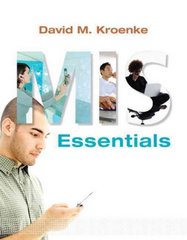Question
The Women's and Children's Hospital have approached you to support their efforts in improving the outcomes for childhood cancer patients. They have tasked you with
The Women's and Children's Hospital have approached you to support their efforts in improving the outcomes for childhood cancer patients. They have tasked you with gathering the requirements for an online survey tool to support childhood cancer patients during and post treatment from radiation therapy. The survey tool is a Health Related Quality of Life (HRQoL) assessment tool where patients can periodically report any symptoms they are experiencing. The results of this reporting can alert health care professionals of any issues that the patients may be developing due to treatment and therefore can act accordingly. This appendix describes background to the problem, the patient journey, the tool, and the scope of the project.
Appendix 1
Background Childhood cancer is the number one cause of disease-related death in Australian children. Treatment for childhood cancer can include radiation therapy1 , where the cancer is treated using multiple tiny doses of targeted radiation that destroys cancerous cells while leaving healthy tissue relatively unaffected. Patients can experience adverse effects during treatment and recovery, such as basic rashes and mood and emotional issues. The adverse effects impact the "quality of life" of the patient. Being able to identify these effects early can help the health care professionals determine suitable treatments and interventions to improve the patient's overall quality of life. Recently, national and international paediatric oncology bodies have called for the integration of Health Reality Quality of Life (HRQoL) assessment into clinical practice. These forms of assessment are periodic surveys that the patient can fill out that provides the health care professionals with consistent measures for assessing the patient's quality of life. They generally consist of a series of self-reported questions (e.g. "It is difficult for me to run") on which the patient responds on a scale between 0 for Never and 4 for Almost always. The individual responses to these questions can provide valuable to understanding adverse effects, while the answers can also be summed to provide overall indicators of their quality of life.
Appendix 2
Patient Journey Patients will have an initial consultation with their radiation oncologist where the radiation oncologist explains the patient's diagnosis and the treatment plan. Childhood cancer patients with a radiation therapy treatment generally undertake treatment over 4-6 months. During this time, they will receive treatment every weekday. Every week, the patient (along with their parents) will have a consultation with a radiation oncologist responsible for that patient's overall treatment. The patient may not always see their radiation oncologist may be on leave or seeing another patient, in which case the patient would see a registrar (a radiation oncologist in training). The oncologists should be aware of any adverse effects the patient has recently report. Patients will also meet with the nurses who would also benefit from being aware of any adverse effects they are experiencing. After treatment, the patient will enter a post treatment period, ranging from 2 to 5 years. During this period the healthcare professionals, including the nurses and radiation oncologist, will see the patient periodically every 1 to 6 months depending on their initial diagnosis and recovery progress
Appendix 3
Patient reported outcome tool In this project, you will identify the requirements for an HRQoL online tool that the patients can use. This tool will be used by the healthcare professionals to have quantitative and qualitative measures of how the patient is progressing. Patients will periodically use the tool to self-report any issues they are having. Patients are expected to report using the tool once a fortnight during treatment, and once a month after treatment for up to 12 months. Although these frequencies may change dependent on the individual patient's treatment plan and should be specified by the oncologist. The proposed tool will be modelled on a validated, internationally recognized paper-based HRQoL tool (PedsQL version 4.0). PedsQL includes paper-pencil self-report by young patients (5-7 years and 8-12 years) and parent-proxy versions for toddlers (2-4 years). The tool has been included as an Appendix. A series of formulas can be used with this tool to calculate an overall score that can be used to track a patient's adverse symptoms over time. The tool should generate summaries of the patient's responses, including the calculated scores and send these summaries to the appropriate health care professionals. The health care professionals should be able to search for specific patients and see a history of their reports. You can expect 30-60 new patients a year to be using this system. There will be approximately 12 radiation oncologists and 15 radiation therapists.
Appendix 4
Initial patient setup It is expected that there would be some need for a system administrator that would be responsible initially setting up a patient in the system, entering their details, diagnosis and treatment. The frequency that the patients need to respond to the tool should be scheduled. Patients (or their parents) will likely need to provide their consent to use the tool.
Appendix 5
Scope Your assignment covers the scope of the HRQoL tool across hardware and software considerations. The tool should be available to patients when they need it.
Given the provided scenario, design an interview outline for an interview with a patient to learn what the information requirements are for the new information system.
Repeat this with a radiation oncologist.
Hint: Make sure the questions help inform you of the needs of the user. You should also have questions that help you understand the users so that you can generate your personas later.
Step by Step Solution
There are 3 Steps involved in it
Step: 1

Get Instant Access to Expert-Tailored Solutions
See step-by-step solutions with expert insights and AI powered tools for academic success
Step: 2

Step: 3

Ace Your Homework with AI
Get the answers you need in no time with our AI-driven, step-by-step assistance
Get Started


